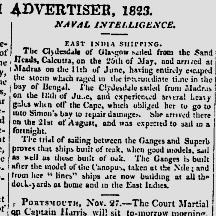Clydesdale (1819 Ship) on:
[Wikipedia]
[Google]
[Amazon]
The ship ''Clydesdale'' was launched at Bay of Quick, Greenock in 1819. She sailed as an
/ref> ''Lloyd's Register'' reported that ''Clydesdale'', M'Kellar, master, sailed for Calcutta on 20 February 1820. In addition to other cargo, she carried 720,000 yards of cotton goods. She arrived back in the Clyde on 5 March 1821, having left Bengal on about 28 October 1820, and from the In 1826 ''Clydesdale'', Rose, master, sailed for Madras and Bengal. In February 1827, she sailed from Bengal, but collided with . Both were damaged and had to return to repair damages. ''Clydesdale'' finally left Bengal for England on 15 March 1827.
In 1826 ''Clydesdale'', Rose, master, sailed for Madras and Bengal. In February 1827, she sailed from Bengal, but collided with . Both were damaged and had to return to repair damages. ''Clydesdale'' finally left Bengal for England on 15 March 1827.
East Indiaman
East Indiaman was a general name for any sailing ship operating under charter or licence to any of the East India trading companies of the major European trading powers of the 17th through the 19th centuries. The term is used to refer to vesse ...
under a licence from the British East India Company (EIC). She was condemned at Mauritius circa June 1827 as unseaworthy while homeward bound from Bengal.
Career
The partnership of R. & A. Carsewell commenced building vessels in 1816. ''Clydesdale'', at 584 tons (bm), was the largest vessel they launched. R & A Carsewell launched ''Clydesdale'' in July 1819, for the East India trade. In 1813 the British East India Company (EIC) had lost its monopoly on the trade between India and Britain. British ships were then free to sail to India or the Indian Ocean under a licence from the EIC. In December 1819 the following advertisement appeared. ''Clydesdale'' did not sail until February. ''Clydesdale'' first appeared in '' Lloyd's Register'' (''LR'') in the supplemental pages in 1819.''LR'' (1819), Supple. pages "C", Seq.No.C98./ref> ''Lloyd's Register'' reported that ''Clydesdale'', M'Kellar, master, sailed for Calcutta on 20 February 1820. In addition to other cargo, she carried 720,000 yards of cotton goods. She arrived back in the Clyde on 5 March 1821, having left Bengal on about 28 October 1820, and from the
Cape of Good Hope
The Cape of Good Hope ( af, Kaap die Goeie Hoop ) ;''Kaap'' in isolation: pt, Cabo da Boa Esperança is a rocky headland on the Atlantic coast of the Cape Peninsula in South Africa.
A common misconception is that the Cape of Good Hope is t ...
on 23 December. Later in 1821 she again sailed for Bengal.
Next, for her third voyage, ''Clydesdale'' sailed to Van Diemen's Land and New South Wales. In 1822 she brought as passengers Richard Aspinall, Warham Jemmett Browne, and Thomas Aspinall, nephew of Richard. In 1821 Richard and Edward Aspinall and Browne had established the trading firm of Aspinall, Browne & Co. in Liverpool. Richard Aspinall and Browne brought with them a large assortment of trade goods. They established the firm of Aspinall Browne & Co. in Sydney, with the intent of acquiring wool for Liverpool. From Sydney ''Clydesdale'' sailed for Calcutta.
 In 1826 ''Clydesdale'', Rose, master, sailed for Madras and Bengal. In February 1827, she sailed from Bengal, but collided with . Both were damaged and had to return to repair damages. ''Clydesdale'' finally left Bengal for England on 15 March 1827.
In 1826 ''Clydesdale'', Rose, master, sailed for Madras and Bengal. In February 1827, she sailed from Bengal, but collided with . Both were damaged and had to return to repair damages. ''Clydesdale'' finally left Bengal for England on 15 March 1827.
Fate
On her voyage back to England on 23 May she put in to Port Louis, Mauritius leaky. She was surveyed, condemned as unseaworthy, and sold for breaking up. Rose and his officers blamed her leaks on the damage she had sustained in her collision with ''Juliana''. A report from Mauritius dated 7 July 1827 stated that the merchant vessel would be bringing back part of ''Clydesdale''s cargo as ''Clydesdale'' had been condemned there."Multiple News Items" ''Morning Post'' (London, England), 1 October 1827, Issue 17730. ''Britomart'' left Mauritius on 14 August, the Cape on 20 September, and St Helena on 5 October. She arrived at Deal on 2 December.Notes
Citations
References
* * * * * {{cite book, last=Weir, first=Daniel, title=History of the town of Greenock, year=1829 1819 ships Ships built in Scotland Age of Sail merchant ships of England Maritime incidents in May 1827